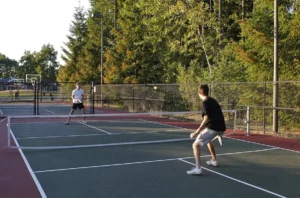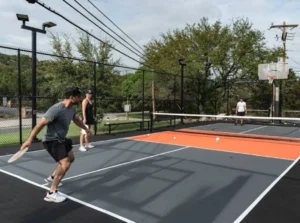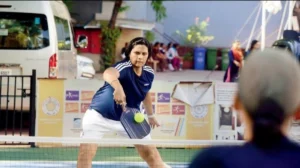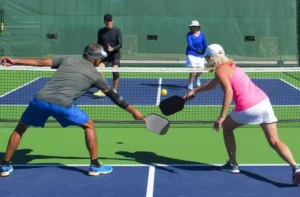Reasons for Gaining Acclaim, Financial Viability and Growth Potential
Pickleball, a sport that has shaken up the entire sporting ecosystem with its reach penetrating key demographics at a rapid pace. An amalgamation of various sports, taking positive and exciting aspects from traditional sports such as Tennis, Badminton and Table Tennis, Pickleball is making a name for itself among sports as well as the entertainment industry at an exhilarating rate.+

The unconventional and relatively modern sport of Pickleball is played with a net placed on the ground that divides the court into two equal halves. It also has a special area known as the “Kitchen”, a designated area on each side of the court, adjacent to the net. The uniqueness of the “Kitchen” lies in the rule that a volley cannot be executed in this area, with it being mandatory for the ball to bounce in this area before it can be hit.
In order to counter the common problem in Tennis, wherein the server has a significant advantage, Pickleball requires both teams to let the ball bounce in their first returns, thus fostering and ensuring longer rallies and integrating a level playing field. It follows a similar odd-even serving system as evident in Badminton. And finally in terms of the scoring, the sport currently has two different scoring systems, each having its pros and cons, with different tournaments utilising different systems.
History of Pickleball
Historically, the sport of Pickleball originated in the year of 1965, when US Congressman Joel Pritchard, in company of his two friends Bill Bell and Barney McCullum experimented in order to come up with a summer pastime. Over the course of the following years, the three founders of the game amended and created certain rules and regulations in order to give the sport of Pickleball a professional structure, legitimizing its existence as a sport.
In the next few decades, the sport attracted players and received significant popularity leading to the creation of the The United States Amateur Pickleball Association, also known as USA Pickleball Association in the year 1984. With the establishment of such an organisation alongside construction of professional Pickleball courts, with the first ever court estimated to be built in the 1960s, the sport of Pickleball has surged, especially in the United States of America.
Fastest Growing Sport over the World

According to a 2022 Sports, Fitness and Leisure Activies (SFIA) Topline Participation report, Pickleball had topped the ranking, becoming the fastest growing sport in the United States for a second consecutive year. Another interesting statistic that puts things into perspective is that, according to estimates there are approximately 36 million active Pickleball players in America alone.
Ever since the COVID-19 Pandemic, the sport of Pickleball has attained international acclaim and global popularity with the game being promoted and widely accepted in Europe, Africa and Asia as well. The Corona Virus came as boon in disguise for this sport, as the concept of social distancing aligned ideally with the rules and regulations of Pickleball.
Introduction and Inception of Pickleball in India

In India, the sport was first introduced by Sunil Valavalkar way back in 2006, but until up to recent times, the sport had remained hidden from audiences and athletes alike. Sunil Valavalkar, now the founder-director of India’s apex Pickleball body (AIPA), was introduced to the sport during his visit to Canada in the year 1999.
A sports fanatic, Valavalkar was highly intrigued by the sport which led him to visit Canada once again in 2006. After realising the potential that the sport of Pickleball commands, Sunil Valavalkar took the plunge as he established the All India Pickleball Association (AIPA) in 2008.
Pickleball as a sport currently has a strong hold within the metropolitan areas, especially Mumbai and Delhi, with major of its audience coming from the secure financial backgrounds. While the sport has adopters from diverse age groups, it is dominantly prevalent in the younger age groups.
According to a survey conducted by the International Institute of Sports and Management (IISM) in collaboration with Krishang Sports, 54.4% of Pickleball players in India belong to the age group of 15 to 25, indicating its relevance among the younger generations. Furthermore, it is also quite popular in the corporate sector with 33% of the players belonging to the range of 25 to 35 years.
Advantages and Upsides of Pickleball

One of the major advantage of Pickleball is that it involves a relatively flatter learning curve, which means that the sport is easy to learn and requires significantly lesser skills hen compared to traditional sports.
In India, majority of the promotion has been through referrals and word-of-mouth publicity. According to the previously mentioned report by IISM, around 75% of the individuals learnt about the sport of Pickleball through their friends and social groups.
From the business perspective, Pickleball is far more financially viable as it requires minimal space. Typically a single Pickleball court requires 880 sq ft of land. In comparison a tennis court requires 2800 sq ft. Thus, approximately three Pickleball courts can be built in the same area as is required by a Tennis court.
Additionally, the equipment requirement is also minimal with the nets installed on the surface itself, thus making them conveniently portable. Even the playing equipment involves just a paddle, which is bigger than a Table Tennis racket but smaller than a Tennis racket and is made up of plastic or carbon fibres and a ball, which is made up of plastic, thus making it easier and economically efficient to procure and produce.

Due to its fast growing acceptance there has an influx of Pickleball courts across cities leading to enhancement of proper Pickleball infrastructure. Additionally, due it’s easy to play nature along with numerous physical benefits such as increased cardio and enhanced reflexes while it being comparatively less taxing on the body, the sport has seen a surge in participation over the years with multiple Governing bodies being established.
The various benefits such as it being the means of socialising, its economically viable nature and easily marketable structure have led to the sport has seen widespread acceptance. Even though there is still no formal international structure with the sport still falling under the category of leisure sports, the sport of Pickleball is experiencing a massive boom in athlete participation especially athletes from tennis, table tennis and badminton backgrounds.
Thus in conclusion, the sport of Pickleball has the potential to become a leading professional sport with trends and analytics suggesting that the sport will continue to further grow and expand. With increase in participation and acceptance, the sport has seen a spike in tournaments with various celebrities promoting and endorsing the sport. Therefore, it can be said that the sport is still in its nascent phases and has massive financial opportunities and significant growth potential.
Written by Chahel Chheda



















Comments